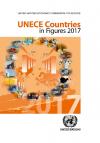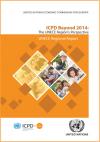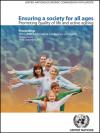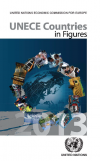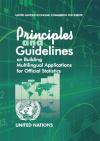Publications
Displaying Results 21 - 40 of 106
- English
In the UNECE region, countries’ approaches to poverty measurement vary significantly. There is a large spectrum of poverty indicators, wide varieties of definitions, methods, thresholds and data sources that are not fully matched by national or international guidelines.This publication provides guidance on applying various measurement approaches and aims to improve the international
- English
The 2nd edition of the Road Map, published in February 2022, can be found here.
The publication provides guidance to national statistical offices on producing statistics for SDGs. It lays out what needs to be done, who are the stakeholders, and what are the opportunities for cooperation. The Road Map deals with
- English
UNECE Countries in Figures presents a profile of social and economic indicators for each of the 56 UNECE member countries.These profiles, prepared by the UNECE Statistical Division, are intended to be of interest to readers not necessarily familiar with statistical terminology or with interpreting statistical tables. A glossary of terms and list of references is available at the back of the
- English
The publication provides a recommendation and good practice guidance on a Generic Law on Official Statistics developed jointly with the European Free Trade Association and Eurostat as part of a broader UNECE statistical capacity building project financed through the United Nations Development Account. The guidance aims to support further development of the legal and institutional frameworks
- English
The idea of viewing individuals’ knowledge and abilities as an asset—as human capital—can be traced back to the 18th century. But human capital is hard to define and measure. Policymakers are calling for ways to understand and quantify human capital, in order to better understand what drives economic growth and the functioning of labour markets, to assess the long-term sustainability of
- English
Across the UNECE region, and across most of the world, populations are ageing, bringing challenges and opportunities which require evidence-based policy responses. Ageing affects virtually all domains of society. The need for relevant statistics is therefore equally wide-ranging.Guided by the framework of the UNECE Regional Implementation Strategy for the Madrid International Plan of Action on
- English
This publication is the third UNECE's report on country-level projects entitled Road Maps for Mainstreaming Ageing, undertaken in UNECE member States at the request of their Governments.(Road Map - ECE-WG.1-22)
- English
UNECE Countries in Figures presents a profile of social and economic indicators for each of the 56 UNECE member countries.These profiles, prepared by the UNECE Statistical Division, are intended to be of interest to readers not necessarily familiar with statistical terminology or with interpreting statistical tables. A glossary of terms and list of references is available at the back of the
- English
The contest was launched as a joint project of the UNECE and the United Nations Population Fund (UNFPA) at the beginning of 2014. A small committee selected ten winners who received their 50 Lari cheques at an award ceremony organized in the UN House in Tbilisi in July. Many of the older writers travelled across the country to take part in the event. They gave little speeches and read poems
- English
По прошествии двадцати лет со дня Международной конференции по народонаселению и развитию (МКНР), состоявшейся в 1994 году в Каире, ООН готовится отчитаться о достижениях и задержках в реализации Программы действий (ПД) МКНР, основываясь на результатах процесса обзора «МКНР после 2014 года». ЕЭК ООН и ЮНФПА провели этот обзор в регионе ЕЭК ООН, результатом чего стали настоящий доклад и
- English
Twenty years after the International Conference on Population and Development (ICPD) held in Cairo in 1994, the United Nations prepares to report on achievements and setbacks in the implementation of the ICPD Programme of Action (PoA), drawing on the results from the ICPD Beyond 2014 review process. UNECE and UNFPA conducted the review in the UNECE region, which resulted in this report and the
- English
The 2013 regional conference was attended by 300 participants from governments, Members of Parliament, academia, civil society and youth organizations. Official delegations from 43 UNECE countries were present. The conference endorsed the Regional Report and advanced the discussion on the population and development agenda beyond 2014 based on the findings and recommendations from the three
- English
This publication aims to diffuse the Conference proceedings to a wide audience, inspire broad public debate, and raise awareness of the issues surrounding the ageing of UNECE Member states, especially as concerns the need for appropriate policy responses to this demographic change.Document TitleClick icon to download pdf TITLE, FOREWORD and CONTENTS
- English
UNECE Countries in Figures presents a profile of social and economic indicators for each of the 56 UNECE member countries. It also includes information about certain territories of UNECE member countries for which separate data are available.These profiles, prepared by the UNECE Statistical Division, are intended to be of interest to readers not necessarily familiar with statistical
- English
This publication is the second UNECE's report on country-level projects entitled Road Maps for Mainstreaming Ageing, undertaken in UNECE member States at the request of their Governments.Document TitleClick icon to download pdf TITLE, FOREWORD and CONTENTSPDF EXECUTIVE SUMMARY, STATEMENT BY MOLDOVA
- English
To allow individuals to live and age actively, societies have a responsibility to invest in conducive frameworks. Such investments can take place in the prevention and health care sectors, in education and labour markets. At the same time, citizens should be able to rely on a supportive infrastructure in case of real need and frailty.The in-depth discussion on active ageing during the UNECE
- English
The move towards global standardisation in models such as the Generic Statistical Business Process Model (GSBPM) and the Generic Statistical Information Model (GSIM), combined with progress on the development of standards for exchanging data and metadata, has drawn the attention of statistical software providers to the possibilities of exchanging software internationally. This has prompted the
- English
The degree of use of administrative sources in the statistical production process varies considerably from country to country, from those that have developed fully functioning register-based statistical systems, to those that are just starting to consider this approach.
Although several subject specific texts exist, there have, until now, been no general, international methodological guidelines
- English
This publication is the first UNECE's report on country-level projects entitled Road Maps for Mainstreaming Ageing, undertaken in UNECE member States at the request of their Governments.Document TitleClick icon to download pdf TITLE, FOREWORD and CONTENTSPDF EXECUTIVE SUMMARY, STATEMENT BY ARMENIA,



